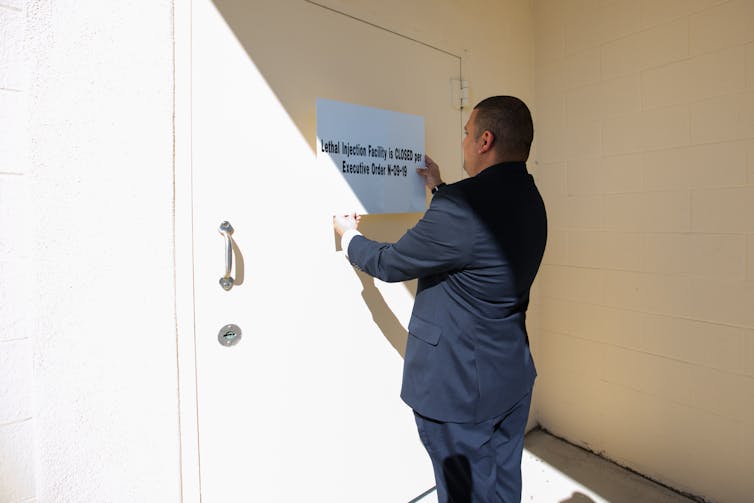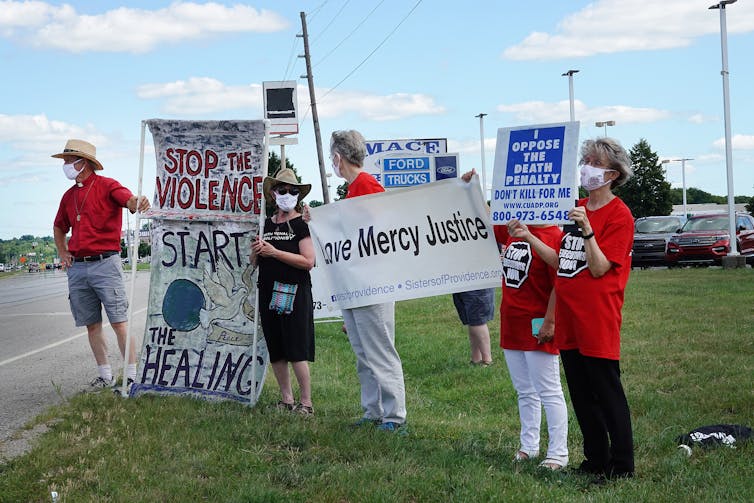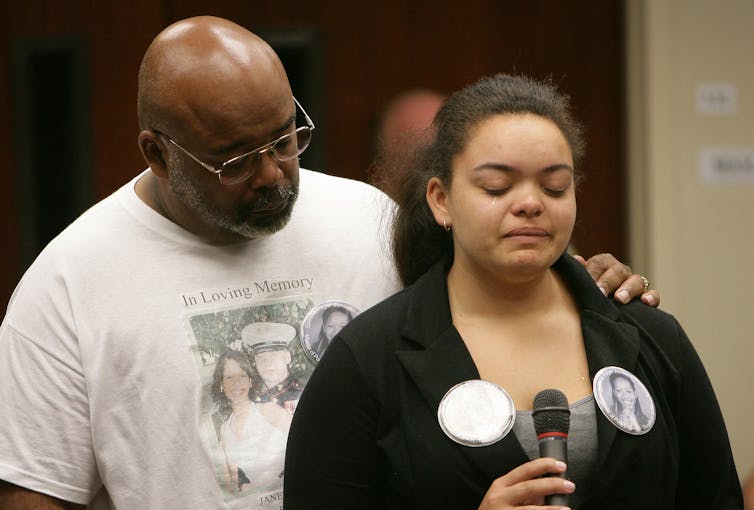When families of murder victims speak at death penalty trials, their anguish may make sentencing less fair
- Written by Austin Sarat, Associate Provost and Associate Dean of the Faculty and Cromwell Professor of Jurisprudence and Political Science, Amherst College
The Trump administration is spending its final months authorizing executions[1]. Ten federal death row prisoners have been killed so far this year[2], ending a 17-year federal moratorium on applying the death penalty.
States, on the other hand, are carrying out[3] fewer executions this year – seven so far – than in any year since 1983, when five people were executed. This is in part because the COVID-19 pandemic poses serious health risks for the personnel responsible for putting prisoners to death[4].
Among the state executions postponed this year[5] was that of Pervis Payne, who in November was granted a temporary reprieve by Tennessee’s governor until April 9, 2021[6]. Payne was sentenced to death in 1988 for the stabbing deaths of 28-year-old Charisse Christopher and her 2-year-old daughter. He also was convicted of assault with intent to commit first-degree murder of Christopher’s 3-year-old son, who survived.
Payne’s is a significant case in America’s death penalty history because, in 1991, the United States Supreme Court used it to affirm[7] the right of murder victims’ families to participate in the penalty phase of capital cases.
Their personal testimony gives surviving family members the chance to tell judges and juries about the impact of crimes on their lives. Victim impact statements are now a regular part of the capital sentencing process[8] in both federal[9] and state capital trials[10].
Victim impact statements have transformed the death penalty process, my research on capital punishment[11] shows – including because of how they have been dealt with by the Supreme Court.
 California, which has 737 people on death row, halted all executions because of the pandemic.
California Department of Corrections and Rehabilitation via Getty Images[12]
California, which has 737 people on death row, halted all executions because of the pandemic.
California Department of Corrections and Rehabilitation via Getty Images[12]
Recognizing victims’ rights
Throughout most of American history, victims played little role in[13], and had little influence on, the criminal justice system.
In the 1960s and 1970s, an organized victims’ rights movement[14] began to emerge in response to[15] the perceived pro-defendant tilt of the Supreme Court led by then-Chief Justice Earl Warren. Crime victims pushed[16] for the right to be heard at critical junctures in the prosecution of offenders, especially when sentencing decisions were made.
That push was especially strong in murder cases[17]. In the 1970s and 1980s, several states, including Tennessee, adopted legislation[18] affording murder victims’ families the right to participate in capital cases.
Defendants in some death cases challenged[19] the use of victim impact statements, asserting that the information they contained was irrelevant to sentence determinations and risked inflaming the passions of the jury.
In 1987, the United States Supreme Court took up one of these challenges. In Booth v. Maryland[20], it considered whether victim impact testimony violated the Eighth Amendment’s ban on “cruel and unusual punishment.” The court, in a 5-4 decision, held that it did.
In its majority opinion[21], Justice Lewis Powell wrote that because victim impact statements present the jury with emotionally compelling testimony, there is substantial risk of prejudice. They focus attention on factors of which the defendants were “unaware” and “divert the jury’s concern from the defendant’s background and record, and the circumstances of the crime.”
Such testimony, then, threatens to undermine the “reasoned decision making we require in capital cases.”
Four years later, following the retirement of two justices who voted against victim impact statements, the Supreme Court used Pervis Payne’s case to reconsider them. This time it found them constitutional in capital cases.
In an opinion authored by Chief Justice William Rehnquist[22], the court conceded Justice Powell’s point that victim impact statements “do not in general reflect on the defendant’s ‘blameworthiness.’”
But it concluded that punishment could and should be meted out differently depending on the harm that is actually done.
“Victim impact evidence,” Rehnquist argued, “is simply another form or method of informing the sentencing authority about the specific harm caused by the crime in question. …” It ensures that the victim is not a “faceless stranger,” he wrote, and redresses the “unfairness” of criminal sentencing, which focuses solely on the life and circumstances of the offender.
 Death penalty opponents near the prison where Daniel Lewis Lee, the first federal prisoner executed in 17 years, was scheduled to be killed on July 13, 2020, in Terre Haute, Indiana.
Scott Olson/Getty Images[23]
Death penalty opponents near the prison where Daniel Lewis Lee, the first federal prisoner executed in 17 years, was scheduled to be killed on July 13, 2020, in Terre Haute, Indiana.
Scott Olson/Getty Images[23]
Grief, anger and racial bias
Victim impact evidence has had[24] a significant impact in death penalty trials since then.
“[I]n the past capital sentencing pitted the defendant against the State,” wrote law professor Marcus Dubber in a Buffalo Law Review article[25] published after the Supreme Court’s decision. Today, Dubber said, the defendant “encounters an even more formidable opponent” during sentencing: the victims’ grieving family.
Research suggests[26] that in many cases victim testimony provokes anger among jurors, compromising the rationality of their deliberations. Jurors use[27] the grief expressed in victim impact statements as a “proxy for the level of defendant’s … culpability, and by implication, the perceived seriousness of the crime,” according to professors Janice Nadler and Mary Rose.
But not all victim testimony is treated equally.
Research shows that jurors tend to take the suffering of some victims’ families more seriously[28] than others, depending on their social status. As law professor Susan Bandes notes[29], “A murder victim who met her assailant in a biker bar, for example, is valued less than a murder victim attacked while withdrawing money from an ATM machine.”
Prosecutors tend to encourage[30] families of middle-class victims to make statements while discouraging families from other backgrounds from doing so.
Scholars have found that victim impact evidence also contributes[31] to the already substantial racial differences in capital sentencing, with juries giving more weight to the suffering of white murder victims’ families.
Mourning in court
Advocates for victims claim[32] that having the opportunity to talk about their loss promotes healing and closure.
But giving a victim impact statement often does not provide[33] a psychological benefit, according to Marilyn Armour, who directs the Institute for Restorative Justice and Restorative Dialogue at the University of Texas at Austin.
 A family member of a murder victim, consoled by her father, gives her impact statement at a capital trial in California on Aug. 16, 2013.
Stan Lim/Digital First Media/The Press-Enterprise via Getty Images[34]
A family member of a murder victim, consoled by her father, gives her impact statement at a capital trial in California on Aug. 16, 2013.
Stan Lim/Digital First Media/The Press-Enterprise via Getty Images[34]
Unlike churches, cemeteries or even therapists’ offices – traditional sites for mourning and expressing outrage at cruel loss – courtrooms may not be “well suited to assist with the healing process,” says Bandes.
When victims speak in capital cases, public scrutiny invades their private suffering. Neither judges nor jurors are trained to deal with that deeply emotional process, and “nobody ensures defendants will respond appropriately” or that victims’ families will receive the justice that they seek.
Not all families of murder victims want the killer put to death[35]. In the case of Daniel Lee Lewis, the first person executed by the Trump administration, the victims’ family members spoke out against[36] his sentence and execution.
They had a voice in court, but did not get the justice they wanted.
References
- ^ authorizing executions (www.washingtonpost.com)
- ^ Ten federal death row prisoners have been killed so far this year (www.americamagazine.org)
- ^ carrying out (deathpenaltyinfo.org)
- ^ health risks for the personnel responsible for putting prisoners to death (deathpenaltyinfo.org)
- ^ postponed this year (files.deathpenaltyinfo.org)
- ^ granted a temporary reprieve by Tennessee’s governor until April 9, 2021 (www.tncourts.gov)
- ^ to affirm (supreme.justia.com)
- ^ a regular part of the capital sentencing process (core.ac.uk)
- ^ federal (ir.law.fsu.edu)
- ^ state capital trials (files.deathpenaltyinfo.org)
- ^ research on capital punishment (press.princeton.edu)
- ^ California Department of Corrections and Rehabilitation via Getty Images (www.gettyimages.com)
- ^ played little role in (doi.org)
- ^ organized victims’ rights movement (www.ncjrs.gov)
- ^ began to emerge in response to (harvardcrcl.org)
- ^ Crime victims pushed (www.newyorker.com)
- ^ push was especially strong in murder cases (justalternatives.org)
- ^ adopted legislation (heinonline.org)
- ^ challenged (journals.sagepub.com)
- ^ Booth v. Maryland (supreme.justia.com)
- ^ majority opinion (supreme.justia.com)
- ^ opinion authored by Chief Justice William Rehnquist (www.law.cornell.edu)
- ^ Scott Olson/Getty Images (www.gettyimages.com)
- ^ has had (lawdigitalcommons.bc.edu)
- ^ in a Buffalo Law Review article (digitalcommons.law.buffalo.edu)
- ^ Research suggests (doi.org)
- ^ Jurors use (dx.doi.org)
- ^ more seriously (online.ucpress.edu)
- ^ notes (www.theatlantic.com)
- ^ Prosecutors tend to encourage (papers.ssrn.com)
- ^ also contributes (cap-press.com)
- ^ Advocates for victims claim (justalternatives.org)
- ^ often does not provide (www.pbs.org)
- ^ Stan Lim/Digital First Media/The Press-Enterprise via Getty Images (www.gettyimages.com)
- ^ want the killer put to death (www.bostonglobe.com)
- ^ spoke out against (www.arkansasonline.com)
Authors: Austin Sarat, Associate Provost and Associate Dean of the Faculty and Cromwell Professor of Jurisprudence and Political Science, Amherst College

